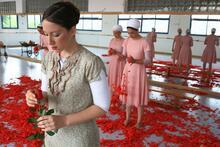Paula Padani
Paula Padani was an influential choreographer, performer, and teacher who explored Jewish themes in her work as she danced throughout Israel, the United States, and Europe. As a child, Padani studied at Mary Wigman’s school of modern dance in Germany. In 1936 Padani illegally immigrated to Palestine. She began creating choreography in Tel-Aviv inspired by the landscape and biblical themes. Following the war, Padani moved to Paris and gave numerous recitals, scoring a brilliant success. Padani was sent by the Joint Distribution Committee to tour some sixty refugee camps in the American-occupied zone in Germany. She became known for her signature solo, Horah. Padani taught with passion in her later life, remaining true to techniques of improvisation. She died in 2001, after the death of her husband.
Early Life and Family
Paula Padani was born in Hamburg in 1913 to Perez Patzanowski (1877–1925) and Chana Rosenstein (1877–1921), who had left Poland and settled in Germany after trying unsuccessfully to emigrate to the United States. The couple had eight children, the second and third of whom died in early childhood. Lovers of art, they sent their daughters [Jana (1904–1996), Fanny (1909–1974), Clara (1911–1964) and Paula] to study dance at a nursery school. Paula later studied classical dance, yoga, Swedish gymnastics, singing, and piano. The deaths in the rapid succession of both parents made orphans of their four daughters and two sons, Max (b. 1914) and Ruven (1915–2002). Paula and one of her sisters were taken in by a Jewish orphanage where she was able to continue her artistic education, notably at a branch of Mary Wigman’s school of modern dance. On leaving school, she went to Dresden to study at Wigman’s school, where she received her diploma in 1935 as one of the last Jewish girls to be admitted to the school.
In 1936 Padani set out on the road to exile via Switzerland, Italy, and Greece, settling for a while at the home of one of her sisters in Athens, where she taught dance. She continued to Damascus, where a friend of her brother-in-law who taught at the Lycée Français helped her enter Palestine illegally via Metullah by passing her off as his children’s governess.
Life and Choreography in Palestine
Both her brothers and one sister lived on A voluntary collective community, mainly agricultural, in which there is no private wealth and which is responsible for all the needs of its members and their families.kibbutzim, but Padani settled in Tel Aviv, where a dance studio that she opened on Dov Hoss Street soon drew numerous adults and children. She created her first choreography and toured the entire region, meeting colleagues who had also arrived from Europe: Mia Arbatova, Tillie Rössler, Gertrud Kraus, the Ornstein sisters, and Deborah Bertonoff. Like them, she was fascinated by the country’s mingling of East and West. The landscape was a source of inspiration for her dance (Song of the Valley, In the Shade of the Orange Tree, Beside the Wells), as were biblical themes (King Saul, Young Joseph, SabbathShabbat), Eastern folklore (Palestine Suite) and the renewed Zionist ideology (Horah). As music for her solo works she chose popular songs, psalms, classical works by Mozart, Bach, Chopin, Albeniz, Debussy, and Honegger, and compositions by young Jewish composers such as Menahem (Mahler-Kalkstein) Avidom (1908–1995), Uriyah Alexander Boskovich (1907–1964) and Marc Lavry (1903–1967).
She soon met Michael Gottlieb, a painter and theater designer born in Austria, a former associate of Bertolt Brecht (1898–1956) who had arrived in the country illegally in 1933 and worked at the Ohel Theater. The two married in Tel Aviv in 1942 and lived the life of artists among the city’s bohemians. When Paris was liberated, Paula danced all night long on the tables of Café Kassit, the popular meeting place of Tel Aviv’s artists and writers
Paris and Later Career
Although they were considered to be among the more prominent artists in the country, the couple decided to emigrate in 1946 and move to Paris, where Michael, who changed his surname to Aram, dreamt of living as a painter. They formed ties with the artists of Montparnasse—Pablo Picasso (1881–1973), Moïse Kisling (1891–1953), the sculptor Ossip Zadkine (1890–1967), the Ballets Russes décor creator Nathalia Gontcharova (1881–1962) and others. Padani gave numerous recitals at the International Dance Archives, the Salle Pleyel, the Palais Chaillot and the Sarah Bernhardt Theater, scoring a brilliant success. The post-war Parisian public was amazed to learn of the vitality and freshness of Jewish artistic life in Palestine. Padani was invited to dance in Brussels and was then sent by the Joint Distribution Committee to tour some sixty refugee camps in the American-occupied zone in Germany. Here her outstanding number was her signature solo, Horah, which was such a success that audiences refused to let her leave the stage. She then made a long tour of the United States, where her solo dances evoked similar enthusiasm.
Back in Paris, she gave up a promising stage career. The initial inspiration provided by the Middle Eastern landscape which had prompted her first creative impulse was missing in the context of existentialist Paris. She devoted herself to teaching and to her family—a daughter, Gabrielle, born in 1951. She joined the famous Wacker studio before renting a studio of her own, first in the rue de Tournon and then in the rue du bac. She taught both professional dancers and amateurs, whose creative talents she loved to nurture. She taught with great passion until the end of her life, remaining true to the techniques of improvisation which had been developed in the Wigman school. She died in 2001, shortly after the death of her husband.
Guilbert, Laure. Conversations with Paula Padani (1995–2000) and Gabrielle de Gail (2003). Unpublished.
Padani, Paula. “Mary Wigman and Modern Dance” (1989), unpublished lecture.




